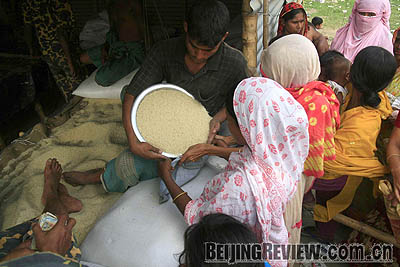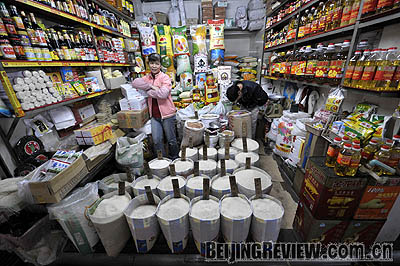|

FEELING THE PRESSURE: A Bangladeshi woman buys rice from a government-run rice store in Dhaka on April 1. The Bangladeshi Government has started its countrywide open market sales of rice to offset the impact of the recent rice price hikes on the country’s poor
ZHA MAN
The global grain market has been on a roller-coaster ride in recent years. Soaring grain prices have roused widespread concern. Since September 2006, grain prices have been skyrocketing around the world. By the end of 2007, the prices of wheat, soybeans and rice soared 112 percent, 75.1 percent and 3.1 percent, respectively. The prices of wheat and corn have reached record highs in 10 years.
Grain price hikes have affected a large number of developed and developing countries, including almost all major grain exporters and importers. Not long ago, the export price of Thai rice doubled to exceed $760 per ton, resulting in "rice crises" in its neighboring countries. Soaring grain prices have cast a dark shadow on the world's grain safety. Some observers warned that grain prices would continue to soar in the next one or two years.
Driving forces
A variety of factors have led to the worldwide grain price hikes. First, growing grain demand in the global market has been the driving force. Since 2003, the world economy has maintained an annual growth of 5 percent for four years in a row. Accelerated economic growth in emerging countries has stimulated global consumption and investment, driving up the prices of goods and services. In 2007, milk consumption rose 2.6 percent year on year in developing countries, 2 percentage points higher than that in developed countries, according to statistics from the UN Food and Agriculture Organization (FAO).
Runaway growth in grain demand has caused grain consumption to surpass output. This has happened in eight of the past 10 years, giving rise to a grain shortage of up to 260 million tons. The world's total grain output rose from 1.872 billion tons in the 1998-99 grain year to an estimated 2.076 billion tons in the 2007-08 grain year, an increase of 10.9 percent, or a net increase of 204 million tons. The net increase of grain consumption, however, was 54 million tons more. Given the robust market demand, the prices of grain and food products are poised to soar.
Second, the emergence of biofuel has been a major stimulus for international grain price hikes. Since the 1970s, many countries have been producing ethanol fuel from corn and biodiesel from oil seeds. In the United States, the largest corn producer and exporter in the world, some 90 percent of ethanol fuel is made from corn. About 1.26 billion bushels, or 32 million tons, of corn were used to produce ethanol in 2004, accounting for 11 percent of the country's total corn output. The rate climbed to more than 27 percent in 2007. It is estimated that the United States will produce 130 billion liters of ethanol fuel every year in the next 10 years, seven times the amount in 2006.
Under the Energy Independence and Security Act of 2007 signed by U.S. President George W. Bush in December 2007, the United States would increase its use of biofuel to 36 billion gallons by 2022. The production of ethanol has cost large quantities of corn, which could have been used to feed humans and animals. The rapid development of biodiesel, which is mainly produced by European countries, also has contributed to the grain price hikes.
Third, devastating natural disasters have directly caused the grain price hikes. The severe drought in North America and Australia, frosts in Russia and Ukraine and the heatwaves in Central Europe have dealt heavy blows to grain production around the world. The world's total grain output amounted to 2.193 billion tons in 2006, down 1.6 percent from the previous year. The output of the three major grain varieties-rice, wheat and corn-totaled 1.968 billion tons, a decease of 41.82 million tons from the previous year. Decreasing grain outputs by major grain exporters, in particular, have roused deep concern.

FOOD SECURITY: A grocery store in Guangzhou keeps its shelves full on April 3. Food prices have generally remained stable in China despite drastic fluctuations in the international market
LIU DAWEI
Fourth, the drastic decline of grain reserves across the world has weakened the foundation for harnessing grain price fluctuations. The world's total grain reserves dropped to 375 million tons in 2006, a decrease of 72.38 million tons, or 16.2 percent from the previous year. To date, global grain reserves have declined for three consecutive years to reach a historical low in three decades. In 2007, global wheat reserves declined 11 percent year on year to an equivalent of only 12 weeks' global wheat consumption, far less than the average level of 18 weeks from 2000 to 2006. As the world's largest wheat exporter, the United States has seen its wheat reserves plummeting to the lowest point in six decades. Global corn reserves can only last seven and a half weeks based on current consumption levels, the lowest in 33 years. As they decline, the role of grain reserves in regulating and stabilizing grain prices has weakened.
Fifth, the inflow of international speculative capital into the grain market has fueled the grain price hikes. In the context of economic globalization, the commodity market, financial market and the market of factors of production have become highly integrated. The risks of investment instruments, such as securities and bonds, have mounted in the wake of the disastrous subprime mortgage crisis in the United States. Therefore, international speculative capital is surging into the grain market. Also, as the U.S. dollar depreciates, grain prices denominated in dollars will further go up, attracting even more speculative capital into the grain market.
A stabilizing factor
The price hikes in resource products and energy in the international market are projected to take a toll on China's grain market. The price hikes on the international market have increased the costs of grain production and trade, fueling hikes in grain shipping costs and the prices of pesticides and chemical fertilizers. In February, the prices of chemical fertilizers, pesticides and animal feed increased 3.5 percent, 0.3 percent and 1.1 percent, respectively, over the previous month and 13.8 percent, 0.7 percent and 3.5 percent, respectively, from the previous year. International grain price hikes have driven up the prices of products with grain as raw materials. For example, food prices in China soared 7.1 percent month on month in February, representing a 2.3-percentage-point increase in the consumer price index.
International grain price hikes also have aggravated China's inflationary pressure. While China was a net grain exporter in 2007, it imported large quantities of soybeans. Statistics show that the country imported 28.7 million tons of soybeans in the 2006-07 grain year, accounting for about 41.76 percent of total soybean imports in the world. The soaring soybean price on the international market keeps the price of edible plant oil high in China. Soaring international grain prices have caused price hikes in many food products, heightening inflationary pressure in the country. The deficit in China's trade in agricultural products is predicted to grow. In the coming years, China will import more soybeans, cotton, edible plant oil and barley. The export of its main exports, such as fruits, vegetables, poultry and animal products and aquatic products, however, will not increase as rapidly. As a result, the trade deficit may expand.
Despite these negative effects, China has withstood the severe challenges posed by grain price fluctuations with its adequate grain supply. It is indeed a stabilizing factor for world grain security. The government has always put grain production at the top of its agenda. It has adopted a series of favorable policies on agriculture. It has increased its subsidies for farmers year by year. The Central Government has earmarked 587.75 billion yuan ($84 billion) to support agriculture in 2008, an increase of 155.95 billion yuan ($22.3 billion) over the previous year. It also protects the interests of farmers by introducing minimum prices for purchasing grain products. Thanks to these policies, China's total grain output grew for four consecutive years from 2004 to 2007, reaching 469.469 million tons, 484.022 million tons, 497.46 million tons and 501.5 million tons, respectively.
Grain reserves are also on the rise. They currently account for more than 35 percent of the country's yearly grain consumption, much higher than the 17 percent-18 percent food security requirement of the FAO. In addition to the large state grain reserves, Chinese farmers own large quantities of grain. Farmers' average per-capita net income reached 4,140 yuan (about $600) in 2007. In real terms, it grew 6.8 percent annually on average from 2003 to 2007. China's rural poor population declined from 250 million in 1980 to 14.79 million in 2007. All these have laid a solid groundwork for food security in the country. China has supported 22 percent of the world's population with only 9 percent of its cultivated land, a great contribution that it has made to world food security.
Grain is a renewable resource. Both China and other countries in the world have the potential for increasing their grain outputs. They will be able to guarantee grain security, as long as they implement correct strategies, reasonably exploit grain resources, give full play to the initiatives of farmers and embrace modern technology. |
